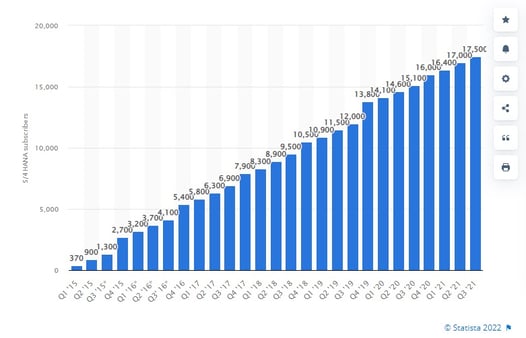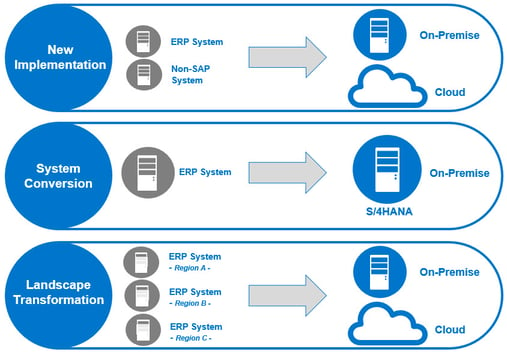Your Guide to Successful SAP S/4HANA Migration
A perfect storm of events over the past several years has led to steady growth in enterprises evaluating SAP S/4HANA.
Digital transformation has increasingly become a competitive imperative across business sectors. A global pandemic and geopolitical volatility have shown just how critical organizational agility and resilience are.
At the same time, SAP’s announcement that they would end application maintenance for Business Suite has turned SAP migration to S/4HANA into an eventual necessity for enterprises using SAP systems.
But questions remain for companies still considering making the jump: What does an SAP migration to the cloud entail? What risks are involved and how to mitigate? What are the benefits of SAP S/4HANA migration? How do we get started on the process? What does an effective data migration strategy entail?
In the sections that follow, we’ll answer these questions and more. By the end of this article, you’ll have a better understanding of what the SAP S/4HANA system is, options for data migration methods and deployment environments, and the key benefits it can bring to your organization.
Quick Takeaways:
- SAP S/4HANA is SAP’s modern ERP system built on the SAP HANA in-memory database.
- Adoption of S/4HANA is 75% or greater among SAP’s largest user groups
- Three primary SAP migration methods — Greenfield, Brownfield, and hybrid — allow enterprises to align their migration strategy with unique business needs.
- Key benefits of SAP S/4HANA include more sophisticated data capabilities, greater efficiency, cost reduction, and higher levels of innovation and resilience.
- Choosing cloud deployment for SAP S/4HANA allows for automated, frequent updates and reduced responsibility for infrastructure management.
What is SAP S/4HANA?
SAP S/4HANA is the software ERP system released by SAP in 2015 — the newest generation of SAP’s Business applications, replacing the old SAP ECC system.
SAP S/4HANA is the cornerstone of SAP’s strategy to help its clients achieve true digital transformation. Built on the SAP HANA in-memory database, S/4HANA enables companies to operate and access data in real-time. As a result, they experience higher levels of flexibility, responsiveness, operational efficiency, and innovation potential.
Since its launch, S/4HANA has seen steady adoption growth from its enterprise users, reaching 17,500 subscribers by Q3 2021.

Its two largest user groups, the Americas SAP Users Group (ASUG) and the German Speaking SAP Users Group (DSAG), have reached 75% and 80% adoption rates (respectively) when adoption is defined as either live on S/4HANA, in the process of moving or planning to move in the near future.
This demonstrates that SAP migration to S/4HANA has become a competitive necessity in many respects, especially as we approach 2027 when SAP will officially end Business Suite application maintenance.
SAP Migration Methods
While most enterprise leaders can see the need for SAP migration due to the benefits of cloud and continuous innovation opportunities, willingness to execute is still lagging in many cases.
Why?
Likely because of the common perception that SAP migration equates to inevitable business disruption. Potential risks like loss of data or broken applications seem unnecessary when the SAP Business Suite status quo is working just fine.
But the past few years have shown organizations that, more than ever, the unwillingness to adapt in the face of change is indeed the riskiest choice of all. “Fine” is no longer competitively sustainable.
Fortunately, there are multiple approaches to SAP migration that enterprises can use to reduce risk, minimize disruption, and align with their current business situation. They are:
- Greenfield - Start from scratch, implementing SAP S/4HANA as a completely new system. This option is best when you’re starting from a non-SAP system or when your current business processes no longer support future strategies.
- Brownfield - The “lift-and-shift” method, which involves converting your current SAP Business Suite system to SAP S/4HANA. This is a good choice when your systems have high levels of existing customization and/or all historical data must be retained.
- Hybrid - A partly greenfield, partly brownfield approach that allows enterprises to maintain some customizations and solutions while redesigning systems and workflows that need modernization.
There are many impacting factors that determine which data migration strategy and approach is best for your organization. The decision is often complex. For this reason, it’s important to choose the right partner to help you execute and guide you through a successful SAP migration process.
Key Benefits of SAP S/4HANA Migration
Now that we have a better understanding of SAP S/4HANA and the methods for migrating to the system, let’s explore key benefits organizations experience when they do it successfully.
Faster Data Processing
With big data at the core of how enterprises operate today, SAP S/4HANA’s data processing bandwidth and speed is a key upgrade from that of legacy SAP ERP systems. The S/4HANA in-house memory database makes scaling up more seamless than ever, eliminating the worry of data lags and enabling companies to make faster, more informed decisions.
Real-time Analytics
SAP S/4HANA is built with AI, machine learning, and predictive data capabilities that transform an enterprise’s ability to leverage analytics for strategic purposes. Real-time analytics powers things like accurate future forecasting and trend analysis while enabling companies to integrate data analytics at every stage of the supply chain and in other core business functions.
Greenskies, a commercial solar developer who has already transformed to SAP S/4HANA, is reaping the rewards of real-time data in the field, showcasing benefits admired by many SAP customers. “We aggregate system generation data to understand how much energy a system is producing and device data to see which devices are producing well and which aren’t,” explained Eric Zenner, VP of IT at Greenskies. “When we combine that with financial data from S/4HANA and project parameters from our custom project management system, our algorithm tells us which solar projects our team needs to service first. This saves us more money and ultimately generates more renewable energy.”
Performance Efficiency
Enhanced speed, bigger bandwidth, and real-time data all contribute to higher performance efficiency in the forms of faster decision-making, optimized processes, time to market, and speed of delivery to end users. Couple this with more streamlined infrastructure and modern applications delivered by SAP S/4HANA, and enterprises that adopt it can expect to experience improved performance efficiency across the entire organization.
Cost Reduction
Migrating from legacy SAP solutions or non-SAP ERP systems to SAP S/4HANA involves the elimination of outdated systems, unnecessary data, and inefficient workflows. Achieving digital transformation through SAP migration means lower total cost of ownership (TCO) related to IT infrastructure.
Innovation Capability
Enterprises with streamlined systems, optimized processes, data visibility, and performance efficiency powered by SAP S/4HANA are able to achieve higher levels of innovation as part of their operating strategy. This happens through more opportunity recognition, quicker problem identification and resolution, and an ability to operate with greater agility.
System Resilience
Last but not least, SAP S/4HANA enables better responsiveness to internal and external factors that impact business performance. This is a critical capability in a business world where digital transformation is happening at an increasingly rapid pace and geopolitical components make a greater impact on private business than ever before.
On-premise vs. SAP Cloud Migration
Prior to embarking on the SAP migration journey, enterprises must decide whether they’ll deploy S/4HANA in an on-premise or cloud environment. Companies may choose to migrate to an on-premise environment when they want to maintain current business processes and the highest levels of customization.
SAP cloud migration, on the other hand,, results in faster access to the latest and most innovative cloud-native technologies and automations not available on premises.
A third option is a hybrid migration approach, in which some systems are migrated on-premise while others switch over to the cloud.

Enterprises that choose SAP cloud migration maintain much of the functionality offered by on-premise SAP S/4HANA while eliminating costs and time resources required to manage and update infrastructure.
Cloud migration also allows enterprises to choose third-party vendors like AWS, Microsoft Azure, and Google Cloud for maximum alignment between vendor offerings and organizational needs.
3 Steps to Successful SAP S/4HANA Migration
As your organization embarks on its SAP migration journey, it’s critical to find a partner with the right expertise and resources to guide you through the process. Protera can help you execute a successful SAP transformation with our proven 3-step process:
- Assess - In this step, we assess existing systems using Protera Arion, an automated migration and management platform for enterprise cloud deployments. We discover system information, analyze risk, generate the correct architectures, and predict your migration timeline.
- Migrate - We accelerate and de-risk your migration with Protera Arion and the best technologies from SAP, AWS, and Microsoft Azure. We use a combination of methods like storage replication, database replication, backup and restore or fresh build.
- Validate - We ensure that your systems are up and running properly, provide hypercare support, and ensure that cost, performance and reliability are exactly what you expect.
Learn more here about Protera’s SAP Cloud Migration services.
If you’re looking for a trusted partner to help you plan and execute your cloud journey with confidence, talk to a Protera expert today.